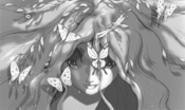Disney originally released Fantasia/2000 in the huge-screen IMAX format. It was a questionable choice: For the nearsighted and/or the aging, IMAX can prove more of an assault than a sensory improvement. The images and music are wonderful enough on their own: They don't need a mile-high screen and a high-tech sound system to make their case for them.
Three of Fantasia/2000's new bits are essentially comic in tone, which gives the film perhaps a better mix of moods than the original, which tended more toward the serious. After a brief sample of sounds and images from 60 years ago, Fantasia/2000 swings into action with Pixote Hunt's essentially abstract visualization of that most familiar of old warhorses, the opening of Beethoven's Fifth Symphony.
Following is Ottorino Respighi's "Pines of Rome," which is afforded altogether the weirdest treatment in the film. Set in a barren but beautiful Arctic landscape, the story seems to be about a school of flying humpback whales who eventually ascend into the clouds and seemingly achieve oneness with the Great Whalehead. Hendel Butoy's lush if sometimes overly dark images and oblique narrative are, well, the trippiest scenes in the new Fantasia; for those still in the grip of the '60s, this segment should be the main inducement for lighting up a giant spliff before settling down in the theater.
For the longest section, a comic setting of Gershwin's "Rhapsody in Blue," director Eric Goldberg has returned to the Al Hirschfeld-inspired style that he earlier used in the design of Aladdin's genie. The 12-minute, multiprotagonist story follows a disparate group of New Yorkers, circa the '30s, as they intersect and work out their fates: a black construction worker, an unemployed guy, a little rich girl, and a henpecked husband with an inexplicable resemblance to Alexander Woollcott. The entire fast-paced episode is a perfect mating of music, visual style, and gags.
There is nothing on display here that's nearly as scary as the original's "Night on Bald Mountain"; the closest contender is Butoy's setting of Hans Christian Andersen's "The Steadfast Tin Soldier" to an excerpt from Shostakovich's Piano Concerto No. 2. The villainous jack-in-the-box head who interferes with the budding romance between a one-legged toy soldier and a mechanical ballerina has the sort of face that would give me nightmares if I were still five years old; parents of other excessively neurotic five-year-olds might want to be prepared. On the other hand, this is certainly the most sensitive cinematic treatment of amputee romance since The Best Years of Our Lives.
Eric Goldberg turns the finale of Saint-Saens's "Carnival of the Animals" into a rapid-fire series of physical gags that surround a wacky flamingo who terrorizes the rest of his staid flock with his new yo-yo. In a departure for Disney, its two minutes are as quickly paced as the wildest of classic Warner Bros. animation.
Donald Duck shows up as the star of another comic episode: He is one of Noah's assistants, marching animals into the ark to a combined version of several of Edward Elgar's "Pomp and Circumstance" marches. (As much as we love Peter Schickele, a.k.a. P.D.Q. Bach, his addition of a soprano voice to the arrangement feels simply out of place.) Animator Francis Glebas turns the biblical story into a touching farce, in which Donald and Daisy each thinks the other has missed the boat.
The closing section is an excerpt from Igor Stravinsky's "The Firebird" (to which Disney bought the animation rights 60 years ago, after Stravinsky saw, and apparently approved of, the original Fantasia's treatment of "The Rite of Spring"), animated by Gaetan and Paul Brizzi. Perhaps the single most visually impressive of the batch, this story of a woodland spirit, a benevolent elk, and the destruction of a forest is also curious in its unmistakable resemblance to Hayao Miyazaki's Princess Mononoke, which played concurrently with Fantasia/2000's January IMAX release. While it's hard to believe that the time scheme of these releases would have enabled Disney to take inspiration -- or simply crib -- from Miyazaki, the similarities are hard to overlook. That said, the resemblance should also serve as an instructive comparison. With apologies to Miyazaki's legions of rabid fans, let me suggest that, at every frame, Disney's realization of these images is far more beautiful and expressive than Miyazaki's.
The whole 75-minute presentation is held together by brief host segments featuring Steve Martin, Bette Midler, James Levine, Itzhak Perlman, James Earl Jones, Angela Lansbury, Quincy Jones, and Penn and Teller. Their appearances are mostly pointless; none is particularly well-served by the material.


